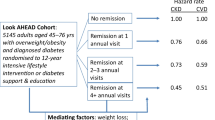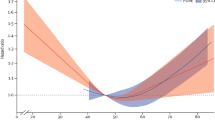Abstract
Background
Hyperglycaemia increases the risk of type 2 diabetes, heart disease and stroke, and is influenced by weight. However, the impact of preceding weight change on blood glycemia levels in late-life is less well understood.
Aim
We studied the interplay between weight change and risk of hyperglycaemia in a prospective cohort of elderly women.
Methods
Elderly Caucasian women (age: 67.1 years at baseline, n = 1173) enrolled in the Prospective Epidemiological Risk Factor study with baseline and 13-year follow-up measurements of BMI and fasting glucose levels (FPG) and no previous history of diabetes or impaired fasting glucose. Multivariate logistic regression was used to determine risk of hyperglycaemia (FPG ≥ 5.6 mmol/L or HbA1c ≥ 42 mmol/mol) in normalweight (BMI ≤ 25 kg/m2), overweight (BMI = 25–29.9 kg/m2) and obese (BMI ≥ 30 kg/m2) women who either lost weight, were weight-stable or had gained weight at follow-up.
Results
Overweight and obese elderly women who had gained weight at follow-up presented an increased risk of hyperglycaemia, OR = 2.7 (1.6–4.6) and OR = 3.2 (1.5–6.8), compared to weight-stable normalweight women. Overweight and obese women who lost weight decreased their risk of hyperglycaemia to a level comparable to weight-stable normalweight women. Overweight and obese women with stable weight presented a two-fold increased risk of hyperglycaemia compared to normalweight weight-stable women.
Conclusions
Losing weight in late life had a positive effect on the risk of hyperglycaemia in overweight and obese women, while further, weight gain increased the risk of hyperglycaemia. The study highlights that strategies to reduce weight in obese and overweight elderly women could have a positive influence on disease burden in late-life.


Similar content being viewed by others
References
Laakso M (1999) Hyperglycemia and cardiovascular disease in type 2 diabetes. Diabetes 48:937–942
Stratton IM (2000) Association of glycaemia with macrovascular and microvascular complications of type 2 diabetes (UKPDS 35): prospective observational study. BMJ 321:405–412
Prince MJ, Wu F, Guo Y et al (2014) The burden of disease in older people and implications for health policy and practice. Lancet 385:549–562
Tabák AG, Herder C, Rathmann W, Brunner EJ, Kivimäki M (2012) Prediabetes: a high-risk state for diabetes development. Lancet 379:2279–2290
International Diabetes Federation (2013) Managing Older People with Type 2 Diabetes—Global Guideline
Harris MI, Flegal KM, Cowie CC et al (1998) Prevalence of diabetes, impaired fasting glucose, and impaired glucose tolerance in US adults. The Third National Health and Nutrition Examination Survey, 1988–1994. Diabetes Care 21:518–524
The Scottish Government (2014) The Scottish Health Survey, 2014 edition. The Scottish Government, Edinburgh
Kirkman MS, Briscoe VJ, Clark N et al (2012) Diabetes in older adults. Diabetes Care 35:2650–2664
Brown AF, Mangione CM, Saliba D, Sarkisian CA (2003) Guidelines for improving the care of the older person with diabetes mellitus. J Am Geriatr Soc 51:S265–S280
Boyle JP, Thompson TJ, Gregg EW, Barker LE, Williamson DF (2010) Projection of the year 2050 burden of diabetes in the US adult population: dynamic modeling of incidence, mortality, and prediabetes prevalence. Popul Health Metr 8:29
Neergaard JS, Dragsbæk K, Kehlet SN et al (2016) Cohort profile: the Prospective Epidemiological Risk Factor (PERF) Study. Int J Epidemiol. doi:10.1093/ije/dyw251
Chamberlain JJ, Rhinehart AS, Shaefer CF, Neuman A (2016) Diagnosis and management of diabetes: synopsis of the 2016 American diabetes association standards of medical care in diabetes. Ann Intern Med 164:542–552
The Scottish Health Survey (2015) Obesity and overweight. Fact Sheet No. 311
Myrskylä M, Chang VW (2009) Weight change, initial BMI, and mortality among middle- and older-aged adults. Epidemiology 20:840–848
Kvamme J-M, Holmen J, Wilsgaard T, Florholmen J, Midthjell K, Jacobsen BK (2012) Body mass index and mortality in elderly men and women: the Tromso and HUNT studies. J Epidemiol Community Health 66:611–617
Zamboni M, Mazzali G, Zoico E et al (2005) Health consequences of obesity in the elderly: a review of four unresolved questions. Int J Obes (Lond) 29:1011–1029
Han TS, Tajar A, Lean MEJ (2011) Obesity and weight management in the elderly. Br Med Bull 97:169–196
Li Y, Burrows NR, Gregg EW, Albright A, Geiss LS (2012) Declining rates of hospitalization for nontraumatic lower-extremity amputation in the diabetic population aged 40 years or older: US, 1988–2008. Diabetes Care 35:273–277
Capes SE, Hunt D, Malmberg K, Gerstein HC (2000) Stress hyperglycaemia and increased risk of death after myocardial infarction in patients with and without diabetes: a systematic overview. Lancet 355:773–778
World Health Organization (2004) Prevalence of visual impairment and selected eye diseases among persons aged >/=50 years with and without diabetes–United States, 2002. MMWR Morb Mortal Wkly Rep 53:1069–1071
Ritz E, Rychlík I, Locatelli F, Halimi S (1999) End-stage renal failure in type 2 diabetes: a medical catastrophe of worldwide dimensions. Am J Kidney Dis 34:795–808
Caspersen CJ, Thomas GD, Boseman LA, Beckles GLA, Albright AL (2012) Aging, diabetes, and the public health system in the United States. Am J Public Health 102:1482–1497
Ford ES, Williamson DF, Liu S (1997) Weight change and diabetes incidence: findings from a national cohort of US adults. Am J Epidemiol 146:214–222
Colditz GA, Willett WC, Stampfer MJ et al (1990) Weight as a risk factor for clinical diabetes in women. Am J Epidemiol 132:501–513
Colditz GA (1995) Weight gain as a risk factor for clinical diabetes mellitus in women. Ann Intern Med 122:481
Resnick HE, Valsania P, Halter JB, Lin X (2000) Relation of weight gain and weight loss on subsequent diabetes risk in overweight adults. J Epidemiol Community Health 54:596–602
Tuomilehto J, Lindström J, Eriksson JG et al (2001) Prevention of type 2 diabetes mellitus by changes in lifestyle among subjects with impaired glucose tolerance. N Engl J Med 344:1343–1350
Knowler WC, Barrett-Connor E, Fowler SE et al (2002) Reduction in the incidence of type 2 diabetes with lifestyle intervention or metformin. N Engl J Med 346:393–403
Centers for Disease Control and Prevention (2003) Age- and sex-specific prevalences of diabetes and impaired glucose regulation in 13 European cohorts. Diabetes Care 26:61–69
DECODE Study Group (2011) National diabetes fact sheet: national estimates and general information on diabetes and prediabetes in the United States. DECODE Study Group, Atlanta
Larsson H, Lingärde F, Berglund G, Ahrén B (2000) Prediction of diabetes using ADA or WHO criteria in post-menopausal women: a 10-year follow-up study. Diabetologica 43:1224–1228
Kanaley JA, Sames C, Swisher L et al (2001) Abdominal fat distribution in pre- and postmenopausal women: the impact of physical activity, age, and menopausal status. Metabolism 50:976–982
Wannamethee SG, Shaper AG, Walker M (2005) Overweight and obesity and weight change in middle aged men: impact on cardiovascular disease and diabetes. J Epidemiol Community Health 59:134–139
Barreira TV, Staiano AE, Harrington DM et al (2012) Anthropometric correlates of total body fat, abdominal adiposity, and cardiovascular disease risk factors in a biracial sample of men and women. Mayo Clin Proc 87:452–460
Kaur J (2014) A Comprehensive Review on Metabolic Syndrome. Cardiol Res Pract 2014:1–21
Flegal KM, Carroll MD, Ogden CL, Johnson CL (2002) Prevalence and trends in obesity among US adults, 1999–2000. JAMA 288:1723–1727
Flegal KM, Carroll MD, Kuczmarski RJ, Johnson CL (1998) Overweight and obesity in the United States: prevalence and trends, 1960–1994. Int J Obes Relat Metab Disord 22:39–47
Acknowledgements
We acknowledge the Danish Research Foundation (Den Danske Forskningsfond) for funding of the Prospective Epidemiological Risk Factor (PERF) study. The foundation had no role in study design, data interpretation, or submission of this manuscript.
Author contributions
KD has done the literature search, statistical analysis, figures, data interpretation, and writing. JSN helped with data interpretation and writing, CC was responsible for study design and provided scientific advice, MK helped with data interpretation and scientific advice, SB and KH contributed to the data interpretation, writing and with scientific advice.
Author information
Authors and Affiliations
Corresponding author
Ethics declarations
Conflict of interest
CC serves as a board member and stock owner in Nordic Bioscience. MK and KH hold stocks in Nordic Bioscience. KD, JSN, SB, and HBN have nothing to declare.
Ethical approval
All procedures performed in studies involving human participants were in accordance with the ethical standards of the institutional and/or national research committee and with the 1964 Helsinki declaration and its later amendments or comparable ethical standards.
Informed consent
Informed consent was obtained from all individual participants included in the study.
Rights and permissions
About this article
Cite this article
Dragsbæk, K., Neergaard, J.S., Christiansen, C. et al. Weight change and risk of hyperglycaemia in elderly women. Aging Clin Exp Res 29, 1095–1104 (2017). https://doi.org/10.1007/s40520-016-0696-1
Received:
Accepted:
Published:
Issue Date:
DOI: https://doi.org/10.1007/s40520-016-0696-1




